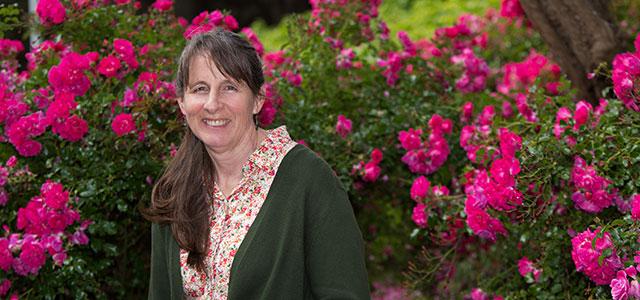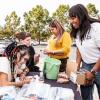
Anne Lown (photo by Elisabeth Fall)
Beyond Survival: Expanding Psychosocial Care for Childhood Cancer Patients and Survivors
“If you don’t ask kids how they’re doing, you don’t end up knowing,” says Anne Lown, assistant professor of social and behavioral sciences at UC San Francisco School of Nursing. It seems like common sense, but until recently, she says, kids with cancer and pediatric cancer survivors too often haven’t been asked. Lown is trying to change that, as a participant in the Psychosocial Standards of Care Project for Childhood Cancer (PSCPCC), an interdisciplinary group of experts and stakeholders who have recently published a set of evidence-based guidelines they hope will form the basis for national psychosocial standards of care.
A social and behavioral epidemiologist, Lown discovered firsthand how important psychosocial care was in 2002, when her then 16-year-old daughter (now a healthy 30-year-old) was diagnosed with acute myelogenous leukemia. Lown and her husband, a UCSF physician, did what many parents of sick children do: they read up on the condition. “He looked up every possible treatment, and I looked up the psychosocial stuff,” Lown says.
Cancer in Childhood Presents Special Psychosocial Risks
Cancer survivors of all ages are at risk for many conditions that can affect both physical and mental health. Depression, anxiety, post-traumatic stress disorder (PTSD), adjustment disorders and (perhaps surprisingly) risky health behaviors are all common among adult cancer survivors. Pediatric cancer patients and survivors, however, may have their own additional challenges. Educational, social and developmental problems – from the physical effects of either the disease or its treatment – can disrupt young lives. Delayed puberty, growth problems and disfigurement can add significantly to a child’s or teen’s distress.
Moreover, a child’s cancer affects the whole family, and the same psychological disorders that may affect the patient can also affect other family members, potentially disrupting family life and functioning.
During her daughter’s treatment, Lown looked at the literature on pediatric cancer and discovered that, while researchers in the nascent field of psycho-oncology had started looking seriously at the psychosocial effects of cancer and its treatment in adults, little attention was directed at the specific needs of pediatric cancer patients and survivors.
Although the National Comprehensive Cancer Network, the Canadian Association of Psychosocial Oncology and the Australian National Health and Medical Research Council all have published guidelines for psychosocial care of adult cancer patients and survivors, there is nothing similar for pediatric oncology patients, says Lown.
Developing a New Standard of Psychosocial Care
The lack of detailed attention to the psychosocial effects of cancer on children prompted Lown, who had done research on childhood trauma, to focus her work more specifically on cancer and its effects. Since 2008 she has published 13 papers on the psychosocial aspects of pediatric cancer; this work led to an invitation in 2012 to participate in an important new project: the development of a set of comprehensive standards for the psychosocial care of children with cancer and their families.
The standards were born out of the frustration and suffering of one family. In 2008, 6-year-old Mattie Joseph Brown was diagnosed with osteosarcoma, a cancer of the bones. Despite extensive treatment, he died the following year. His family’s struggles to cope with his disease and the effects of its treatment without adequate support prompted his parents, Peter Brown and Vicki Sardi-Brown, to found the Mattie Miracle Cancer Foundation in his memory, focusing on increasing research on and expanding access to psychosocial support for children with cancer and their families.
In 2012, the foundation sponsored a symposium and a briefing on Capitol Hill to talk with legislators about the importance of universal psychosocial care for children and families dealing with cancer. Their discussions with lawmakers convinced foundation leaders that they needed better evidence and more specific recommendations about what good care looked like if they wanted to get meaningful legislation enacted. Lown says, “They walked away from Congress with an understanding that they needed to step back and propose guidelines based on an extensive review of the literature.”
Lown, who had worked with several of the researchers who were tapped to head the project, was invited to lead a systematic review of the research on long-term follow-up care. She and her co-investigators found that, despite ample evidence of the potential long-term psychosocial effects of childhood cancer, survivors weren’t being screened for problems consistently.
Barriers to Psychosocial and Long-Term Follow-Up Care
“Some hospitals have great programs and interventions to provide psychosocial support to children and their families, but it’s quite uneven,” says Lown. “[Patients at] some hospitals tend to have much less access to psychosocial care both during and after treatment.” Most of the psychosocial care available is funded through philanthropy, particularly at large, reputable cancer centers, which can more easily attract donors.
Access to long-term follow-up care to monitor the health of survivors, who are vulnerable to late health effects, is also limited by the availability of clinicians with expertise in typical health problems that emerge in long-term childhood cancer survivors. Many childhood cancer survivors return to their primary care providers for continuing care once they’ve completed cancer treatment, but these clinicians may not have the skills and knowledge to adequately screen and treat these patients for the specific health problems that confront survivors. Primary care providers may have even less awareness of the psychosocial issues faced by survivors.
Lown adds that part of the reason survivors do not receive long-term follow-up care is that it is not always reimbursable by insurers. She notes ruefully that her daughter, like too many survivors, has had trouble getting appropriate long-term follow-up care because, until recently, she didn’t have insurance that covered it.
Even the patients may not be aware of the need for health screening and care, says Lown. “Survivors often don’t pursue specific long-term follow-up care. Sometimes it’s related to not wanting to think about the cancer, and sometimes, if somebody has had cancer as a young child, they may not identify as a cancer survivor. We wanted to have some guidelines that would make people aware of the importance of long-term follow-up care.”
The systematic review Lown led, “Psychosocial Follow-Up in Survivorship as a Standard of Care in Pediatric Oncology,” was published in the December 2015 issue of Pediatric Blood and Cancer, alongside 14 other articles and an introductory paper, as part of a special issue devoted to the topic of psychosocial care for pediatric cancer patients and survivors. Together, they detail the first psychosocial standards of care, which include psychosocial screening, support of parents and siblings, opportunities for social interaction and psychoeducation. The PSCPCC hopes these standards will form the basis of a push for universal psychosocial support for childhood cancer patients and survivors.
As of this writing, the standards have the endorsement of six national professional organizations. In addition, the Mattie Miracle Cancer Foundation continues to approach other organizations for their support, which, says Lown, is crucial to getting the standards more widely implemented. She says, “Eventually, we hope it will be part of the criteria for accreditation for cancer centers. One reason our standards were very specific and limited to 15 is so that cancer centers can implement and document they are doing the things outlined in them.”
Improving the Lives of Childhood Cancer Patients and Their Families
Lown’s personal work helping children and families cope with cancer is ongoing. She serves as a patient advocate for Children’s Oncology Group. After her daughter completed treatment, Lown stepped into the role on the advice of a nurse who was impressed by Lown’s advocacy and by the piles of articles she carried around with her. She has also been a member of the Sibling Partnership for Advocacy and Research for Childhood Cancer – a model academic/community-based collaboration working with SuperSibs!, a program of Alex’s Lemonade Stand Foundation – with the goal of bringing attention to the needs of siblings, who are often ignored and neglected during treatment of their brother or sister.
On the research front, Lown continues to look for ways to improve the lives of young cancer patients and survivors. She is working with Cynthia Kim, a pediatric acupuncturist and associate professor of pediatrics at UCSF, and Chris Dvorak, Robert Goldsby and Alexis Melton – all UCSF Benioff Children’s Hospital pediatric hematologist/oncologists – to investigate an acupressure intervention to help pediatric oncology patients manage symptoms such as pain, nausea and anxiety, which, in addition to being unpleasant, may also be linked with PTSD even after treatment has ended. A yearlong pilot study in children receiving bone marrow transplants went well, she says, and she and her colleagues hope to secure a grant from the Patient-Centered Outcomes Research Institute to do a three-year randomized control study to demonstrate the intervention’s effectiveness.
The need to improve both the long-term physical and psychosocial well-being of childhood cancer patients and survivors is growing, says Lown, for a very happy reason: More children than ever are surviving cancer and growing into adults with long-term needs. According to the National Cancer Institute, the five-year survival rate for children under 20 diagnosed with cancer rose from just over 50 percent to more than 80 percent between 1975 and 2010.
As Lown says, “Now that people are surviving, we’re recognizing the long-term psychological and social impact that childhood cancer has had on these kids. If we can provide ways to make it less distressing, that’s a good thing.”



